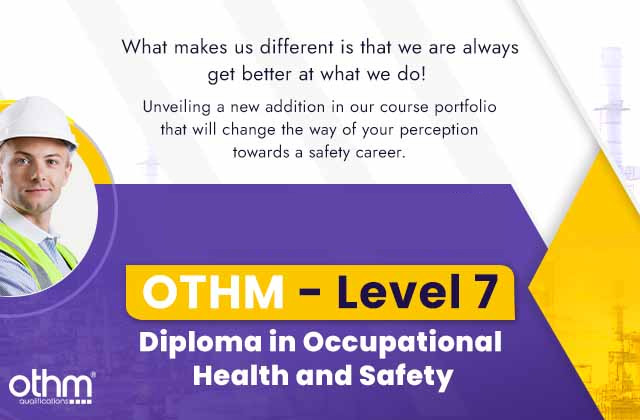
OTHM Level 7 Diploma in Occupational Health and Safety Management
The OTHM Level 7 Diploma in Occupational Health and Safety Management is designed for individuals aspiring to become health and safety professionals. This qualification is tailored for learners who bear the responsibility of formulating and implementing daily health and safety procedures within an organization. Typically, these individuals are managers seeking to enhance their knowledge and skills in this field.
The aim of the OTHM Level 7 Diploma in Occupational Health and Safety Management is to cultivate managerial skills in occupational health and safety. This is particularly targeted at managers possessing the authority and personal qualities necessary to translate organizational strategy into efficient operational performance.
The qualification mirrors contemporary practices in Occupational Health and Safety Management, providing learners with the opportunity to enhance their in-depth comprehension of occupational health and safety within the workplace.
Upon successful completion of the diploma, individuals will qualify to apply for Certified membership at the Cert IOSH level.
Our Occupational Health & Safety Courses
-
NEBOSH Courses
»NEBOSH IGC »NEBOSH IDIP »NEBOSH PSM »NEBOSH Certificate in Fire Safety »NEBOSH EAW » NEBOSH HSW/HSA »NEBOSH Incident Investigation -
IOSH Courses
» IOSH Managing Safely -
OTHM Courses
» OTHM Level 3 Certificate in OHS » OTHM Level 6 Diploma in OHS » OTHM Level 7 Diploma in OHS » OTHM Level 7 Diploma in EMS
OTHM Level 7 Entry Requirements
For entry into the OTHM Level 7 Diploma in Occupational Health and Safety Management qualification, learners will be expected to possess:
 A minimum of a Level 6 qualification such as the OTHM Level 6 Diploma in Occupational Health and Safety or equivalent Level 6 qualification; or
A minimum of a Level 6 qualification such as the OTHM Level 6 Diploma in Occupational Health and Safety or equivalent Level 6 qualification; or An honours degree (2.2) with relevant knowledge and experience in the occupational health and safety sector
An honours degree (2.2) with relevant knowledge and experience in the occupational health and safety sector
OTHM Level 7 Age Criteria
 Learners must be 21 years or older at the beginning of the course.
Learners must be 21 years or older at the beginning of the course.
OTHM Level 7 Diploma in Occupational Health and Safety consists of 6 Units
 Health and Safety Management Practice (20 credits)
Health and Safety Management Practice (20 credits) Effectiveness of Health and Safety Management Systems (20 credits)
Effectiveness of Health and Safety Management Systems (20 credits) Factors Affecting Risk and Strategic Risk Intervention (20 credits)
Factors Affecting Risk and Strategic Risk Intervention (20 credits) Strategic Commitment to Health and Well-Being (20 credits)
Strategic Commitment to Health and Well-Being (20 credits) Sustainability and Ethics in Health and Safety Practice (20 credits)
Sustainability and Ethics in Health and Safety Practice (20 credits) Advanced Research Methods (20 credits)
Advanced Research Methods (20 credits)
Need more info, on OTHM Level 7 – Diploma in Occupational Health and Safety
+919791082789☎ 1800 121 4246 info.india@greenworldsafety.com
Is this qualification equivalent to a degree?
The OTHM Level 7 diplomas, positioned on the Regulated Qualifications Framework (RQF), are equivalent to master’s degrees in terms of academic level. Nevertheless, these diplomas are more concise, comprising 120 credits. To attain a complete master’s program, learners are required to advance to the dissertation stage (60 credits) in collaboration with a university partner.
Progression after completing the qualification
The OTHM Level 7 Diploma in Occupational Health and Safety Management empowers learners to advance within their current employment or explore new opportunities. Additionally, it provides a pathway for further academic pursuits.
Given that this qualification is endorsed and overseen by Ofqual (Office of the Qualifications and Examinations Regulation), eligible learners have the opportunity to seamlessly progress to a Master’s top-up program at numerous universities, often with advanced standing.
What is the assessment and verification method?
All modules within this qualification undergo internal assessment by the center and external verification by OTHM. The qualifications are criterion-referenced, contingent upon the attainment of specified learning outcomes.
To attain a ‘pass’ for a unit, learners are required to furnish evidence demonstrating their fulfilment of all learning outcomes and adherence to the standards outlined by the assessment criteria.
The determination that learners have successfully met the assessment criteria is made by the assessor. It is the responsibility of the assessor to furnish an audit trail, illustrating the process by which the judgment of the learners’ overall achievement has been reached.
